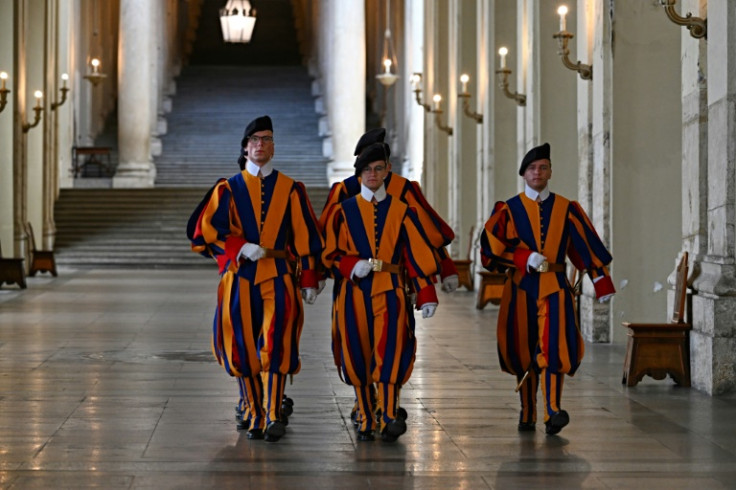Defending The Pope: Behind The Swiss Guards' Armour

It takes over an hour to don the colourful uniform of the pope's Swiss Guards, and new recruits soon discover they cannot buckle up armour weighing 15 kilogrammes by themselves.
Jeremy and Paul, whose surnames cannot be published for security reasons, will soon be sworn in as guards at the Vatican, joining an ancient, prestigious body responsible for protecting the pope.
For the special occasion, 21-year-old Jeremy swaps his T-shirt and sneakers for highly polished metal garb selected from among the armour, muskets, swords and helmets in the barracks' armoury.
"There are two of us to put on the whole thing: the collar around the neck, the chest, the back, the epaulettes and the helmet. It takes about an hour and a half," he told AFP.
The Swiss Guards, the world's oldest practising army, was founded by Pope Julius II in 1506 and is famous for its blue, yellow and red striped uniform.
But three times a year -- Christmas, Easter and the swearing-in -- they adorn themselves with the shiny, heavy armour.
Carpenter Jeremy, who comes from a farming family near Fribourg in Switzerland, will take the oath on Saturday in the presence of his family and friends.
Tall, blond and blue-eyed, Jeremy will be pledging along with 22 others to "sacrifice his life" for Pope Francis for at least 26 months.
The new recruits will raise the number of currently serving Swiss Guards to 125.
"It's a curious world, the more you look into it, the more you want to join," Jeremy said, adding that he felt "pride and emotion" when he put on the uniform for the first time.
A few metres further on, in a courtyard hung with the flags of the Swiss cantons, 22-year-old Paul is part of a small group rehearsing the upcoming oath-taking.
Like the others, Paul did a month of practical training in Switzerland before undergoing another at the Vatican.
He does both day and night patrols, guarding the gates to the Vatican and key areas within it.
"When you arrive here, you think 'wow'," he says, as he stands in the gilded Apostolic Palace. Just outside the door, hordes of tourists photograph the Sistine Chapel.
"At first, we spend our shifts looking at all these paintings, it's fabulous," he said.
Paul was inspired to join up during a 2016 family trip to Rome.
Luckily, he met the admission requirements: unmarried, male, Swiss, a practising Catholic, aged between 19 and 30, at least 1.74 metres tall, and bearing, according to the rules, "an impeccable reputation".
Like all new recruits, he has to learn a lot in record time: how to speak Italian, salute, march in formation, wield the halberd, stand guard, and also recognise those regularly coming and going from the Vatican.
"It's an honour for the Swiss," said Paul.
Nonetheless, he admitted "it's very complex, the work is extremely varied", and his knowledge is regularly assessed as part of his training.
New guards undergo a medical examination and are also encouraged to take part in sports, as "it's quite demanding to be on your feet for hours on end," said Jeremy.
"We always have to be ready to intervene if something happens," he said -- though the guards share papal security responsibilities with the Vatican police.
Swiss Guards are also expected to behave impeccably, as they are often in the public eye.
"The Pope once said that we were his calling card," Jeremy said. "We are told that we are the most photographed Swiss in the world!"
Unlike many men their age, there is no painting the town red for Swiss Guards.
"It's not a monastery, you're allowed to go out, but service is the priority. It gives us a sense of duty."
Many guards attend mass or spiritual retreats. The rest of the time they explore Rome, go to the nearby beach, or run in the lush Vatican gardens.
"We live in a world full of history, we are very privileged," said Jeremy.
"It's a big family, with a great sense of camaraderie and mutual support."



© Copyright AFP 2024. All rights reserved.




















